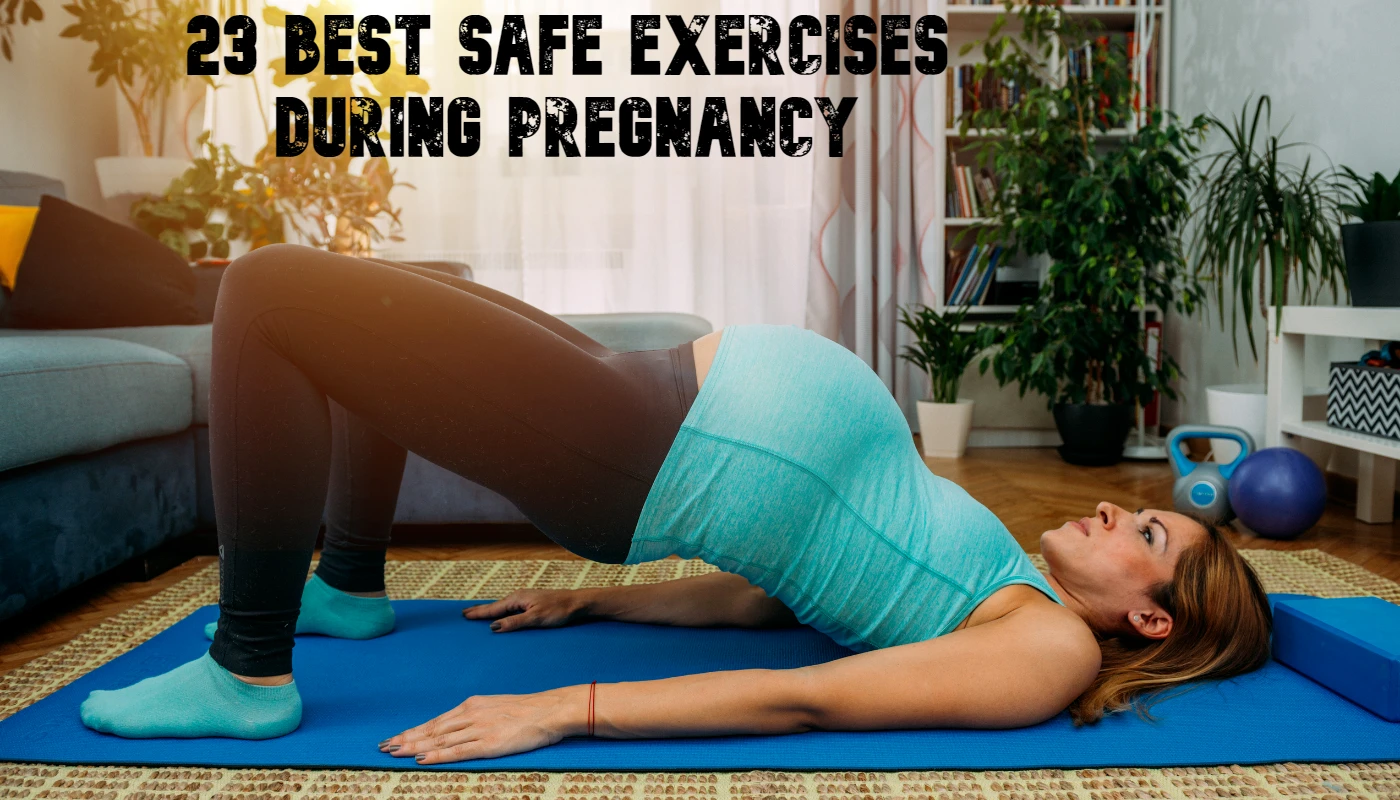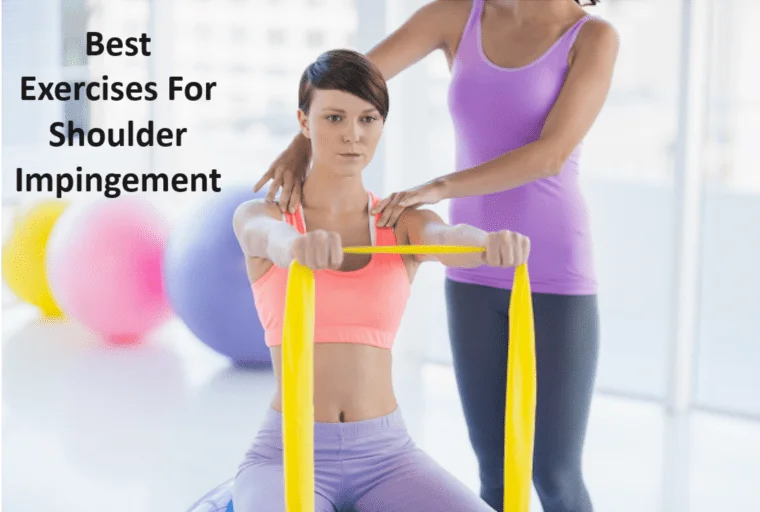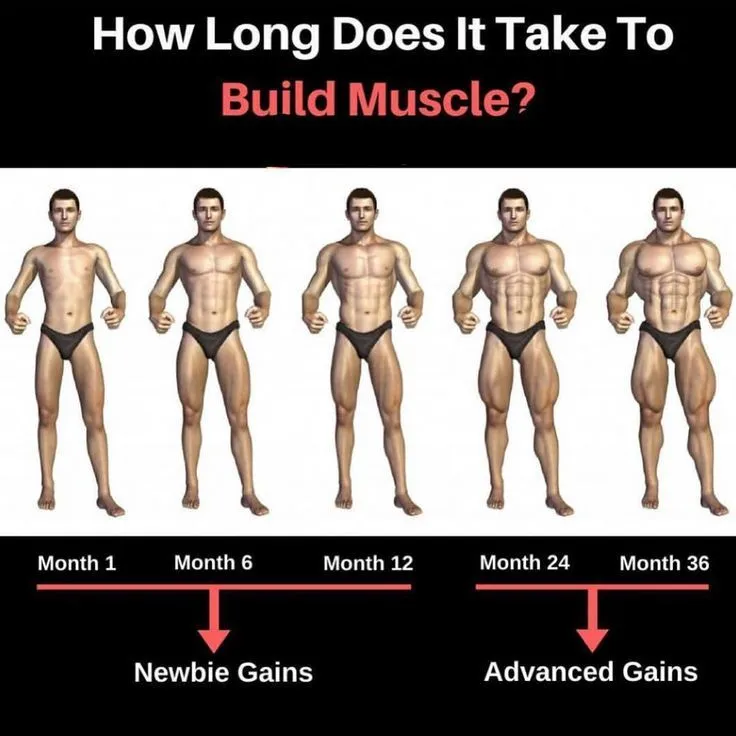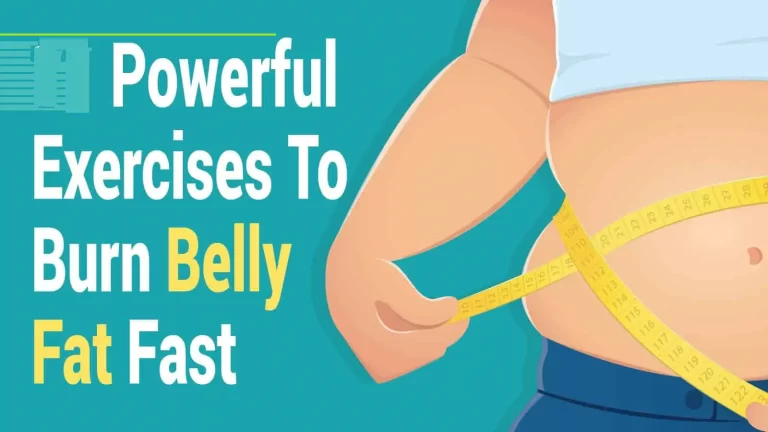23 Best Safe Exercises During Pregnancy
Introduction
Maintaining a strong core during pregnancy is crucial because it will reduce back pain, SI joint pain, setches, and the discomfort associated with labor, delivery, and recovery.
While this is true, there are a lot of things to keep in mind when performing core exercises, and they should be taken carefully to avoid aggravating conditions like “diastasis recti,” which can cause problems for you even after giving birth.
A Few Tips For Safe Exercises During Pregnancy Are As Follows :
- It’s acceptable if you weren’t an active person before becoming pregnant! You can begin at any moment, but to avoid overdoing it, start out slowly and gauge how you feel.
- If everything feels normal, you can carry on with your regular exercise regimen during the first trimester.
- It is advised to start reducing the intensity of your workouts in the second and third trimesters and to start altering things like high-impact activities, leaping, and supine core exercises.
- Long periods of time spent exercising while supine (laying on your back) are not advised after the first trimester.
- Exercise should not be done in extremely hot or humid weather as this might raise body temperature and induce dehydration or other negative effects.
- Avoid overdoing any abdominal workouts as this might put more strain on the core, especially the obliques.
Exercises involving sudden movements, twists, or turns should be avoided.
- The transverse abdominis, nature’s support belt—the muscles closest to the baby—is the most crucial core to strengthen!
- Although it may sound redundant, consult your doctor before starting any new fitness regimen. Furthermore, it is incorrect to check for diastasis recti (DR) during pregnancy because it is natural for our core, the rectus abdominis, to separate during pregnancy in order to make room for the growing baby, but only after delivery. You can perform a DR check.
- Studies show that exercise during pregnancy is not only acceptable but also advised. Even today, pregnant women, personal trainers, and the general public continue to have false beliefs and prejudices about physical activity and pregnancy.
- Core strengthening exercises are one of the things that pregnant women are most afraid of.
- Some may worry that they may harm the unborn child or that the pregnant woman’s core muscles will be harmed.
- Some may even choose to completely disregard the core due to the false belief that it is useless during pregnancy.
- This causes a lot of women to shy away from properly or functionally strengthening their abs. This is a major “miss” when it comes to prenatal exercise.
- Before we go any further, let us define “core.” The muscles in our abdomens are much more than just a “six-pack.” Imagine your core as a multidirectional, three-dimensional, cylindrical muscle unit.
- These muscles are located at the top and bottom of the cylinder, respectively, of the diaphragm and the pelvic floor, and include the transverse abdominus, obliques, rectus abdominus, and erector spinae. This three-dimensional structure serves as the spine’s support.
- The strength of a pregnant woman’s core muscles is essential for maintaining a neutral spine during the forward shifting of weight that occurs as the baby grows. This helps to reduce muscle soreness and tiredness.
- Insufficient trunk strength may allow the growing baby’s weight to push the pelvis forward, resulting in a sway back (lordosis). This extended posture may cause a very painful misalignment of the spine.
- Regaining a neutral pelvic posture during pregnancy might be facilitated by strengthening your core. The American Congress of Obstetricians and Gynaecologists states that low back discomfort affects over 60% of pregnant women. Back and abdominal muscular strengthening could reduce this risk.
Cardio For All Three Periods
Cardiovascular exercises such as walking, swimming, jogging, and stationary cycling are strongly advised during all three trimesters of pregnancy.
The U.S. Department of Health and Human Services Physical Activity Guidelines for Americans suggest receiving at least 150 minutes of moderate-intensity aerobic activity each week unless your doctor has instructed you to alter your physical activity.
You can continue engaging in high-intensity exercises like running throughout pregnancy if you’re accustomed to doing so or if your level of fitness permits it, of course.
23 Best Safe Exercises During Pregnancy
The greatest safe workouts and efficient prenatal core exercises are listed below.
- The first step in any prenatal exercise program to develop core strength is to ensure that the abdomen is engaged.
Sitting knee lift
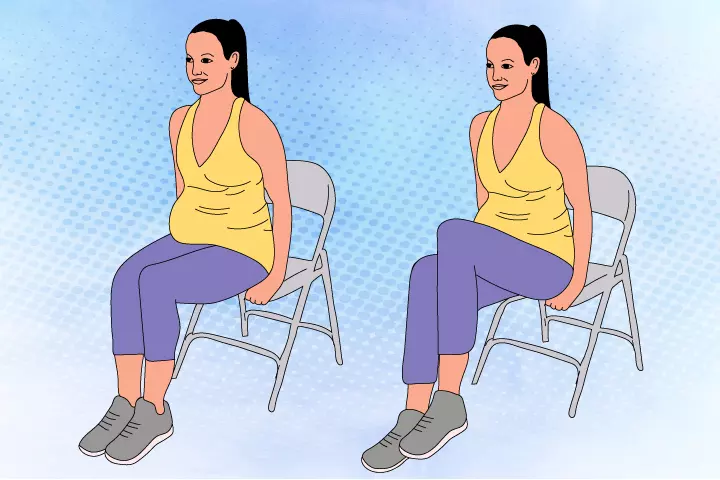
I suggest utilizing an exercise ball, a chair, or the edge of your couch.
Steps To Follow:
- Take a seat close to the chair’s edge.
- Maintain a level foot placement right beneath your knees.
- Keep your hands beneath your hips, palms down.
- Bend your left leg till it tilts your pelvis and activates your pelvic floor, then slowly compress your abdomen.
- Then, as you release the breath, carefully raise your left knee up to your chest.
- Taking a breath, return to your starting position by lowering your left foot to the ground.
- Continue with your right leg.
Note: I advise performing two to three sets of eight to twelve repetitions. You can also add little weights (2 to 5 pounds) to each ankle during the first trimester.
Side-Lying Crunch
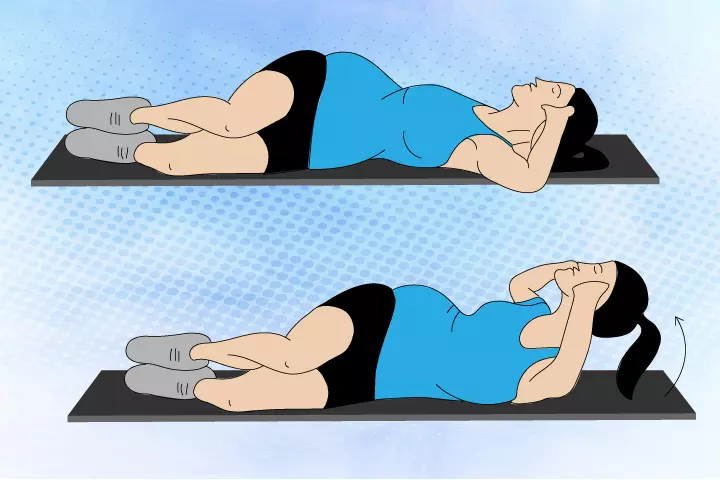
Steps To Follow:
- Lie down on the ground.
- With your body slowly rolling to the left, bend your knees to form a 30-degree angle with your hips.
- Your knees should rise about 6 inches off the ground as you roll your torso to the right.
- Make sure the back of your left shoulder and the shoulder blade are where your weight is resting.
- Place both hands behind your head so that your fingertips meet; do not strain your neck.
- Assume a diagonal curvature of the torso and raise it until it nearly touches your right knee.
- As high as you can, raise.
- As you perform the aforementioned exercises, your left shoulder will lift slightly off the ground.
- Bend your arms somewhat higher as you bring them up to your knees.
- After that, return to your starting position by lowering yourself with your hands behind your head.
- Do the same on the opposite side.
Note: Complete two sets, 10–12 repetitions on each side.
Core Breathing

Steps To Follow:
- Maintaining a straight back, you can comfortably stand or sit.
- Put one hand on your chest and the other on your waist or tummy.
- Breathe deeply until your ribcage expands, which should take five to ten counts.
- Breathe out for five to ten counts, then return your ribs to their closed posture.
- Contracting the front of your pelvis and your tailbone will help you relax your muscles.
- Ten deep breath cycles should be repeated.
Seated Ball Stability Hold
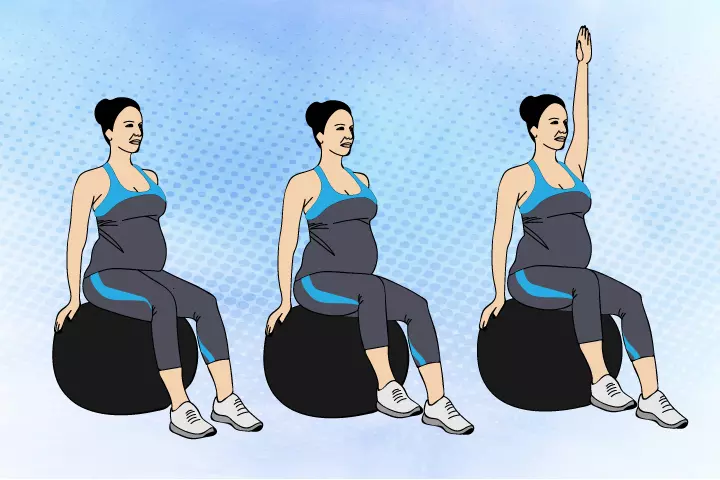
Like a ground version of a bird dog, but sitting on an exercise ball.
Steps To Follow:
- Take a seat upright on a stability ball.
- To keep your equilibrium, place your hands on both sides of your body.
- As you raise your left arm above your head and take a deep breath from your core, raise your right foot off the ground.
- Return to the starting position after two or three seconds of holding.
- Continue with your right arm and left foot.
Side plank/Modified side plank
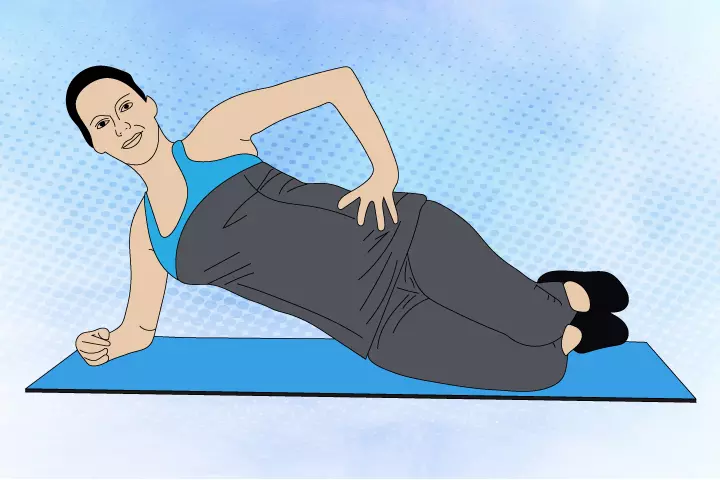
There are various techniques for side planking. These are some alternatives to consider when pregnant.
Steps To Follow:
- Place your elbow squarely under your shoulder while lying on your side.
- Bend the knees and stack them on top of each other, without constricting, with one straight, one bent, or straight out if it feels comfortable.
- Maintain a neutral spine, keep your back flat, and focus on your core breathing.
- Maintaining a straight head and neck, lift your body and squeeze your hips to create a straight line from your head to your hips.
- Remember to breathe throughout the 20–30 seconds when you hold this position.
- Continue on the opposite side.
The standing crunch
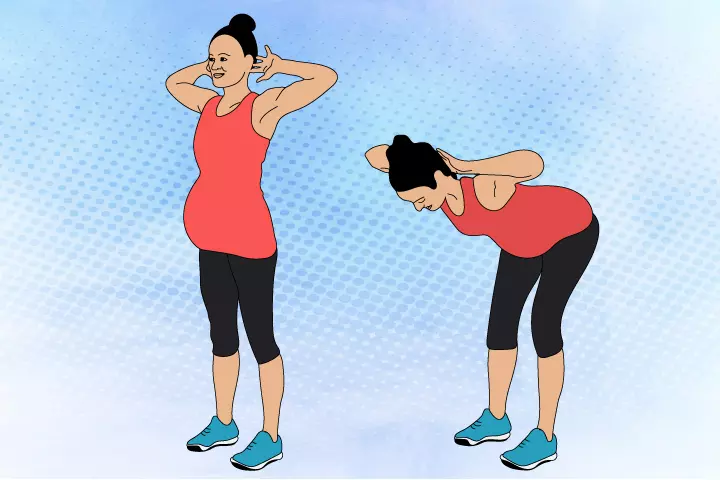
This is suitable for use in all phases and is similar to a crunch that you would perform when lying down.
Steps To Follow:
- With your hands behind your head, your knees slightly bent, and your feet hip-distance apart, assume a straight posture.
- Take a breath. tuck your pelvis and pull in your belly button.
- Let out a breath and bend forward, contracting your abdominal muscles in the same manner as when you lie on your back.
- Try to complete 15–20 repeats.
The Standing Bicycle
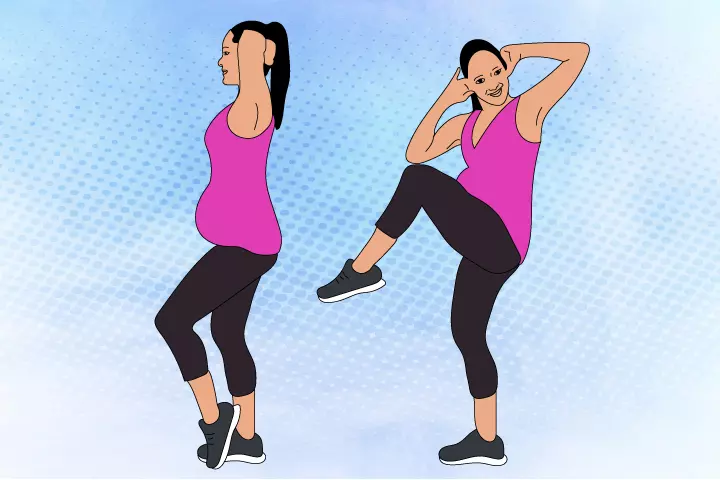
This is a great exercise to strengthen your core and aid with balance.
Steps To Follow:
- With your hands behind your head, your feet hip-width apart, take a breath.
- Then let the breath As you crunch, raise your left elbow to meet your right knee.
- Return to the starting standing position and repeat with your right elbow and left foot.
- Try for 10–20 repetitions.
Kegels
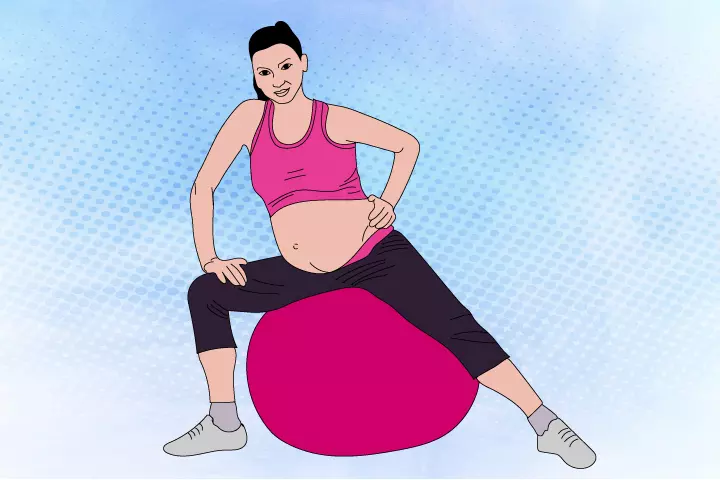
Kegel exercises aid in toning the pubococcygeal (PC) muscle, which regulates urine flow, supports your developing child, guards against hemorrhoids, maintains the tone of the vaginal muscles, and facilitates childbirth.
Steps To Follow:
- Take a comfortable seat on the exercise ball and take a deep breath.
- As you inhale, let your tummy expand as you take in more air.
- When you’ve taken in enough air, slowly release the air by exhaling.
- Try to match the length of your 5–10 count exhale with a 5–10 count inhale.
- Try to tense your vaginal muscles the next time you breathe. It should feel like your muscles tensing up when you really need to urinate but have to hold it in.
- Unwind your shoulders, face, and neck.
- Only your pelvic floor muscles should feel tense and constricted at this time.
- After holding the position for five to eight counts, carefully release the pose.
- Aim to perform this 20 times a day, and progressively increase the number.
Wood Chop
Rotational strength with functionality (resistance band required)
Steps To Follow:
- Set one handle down on the ground and use both feet to stand on the band.
- Using both hands, hold onto the opposite handle.
- Make your abs tense.
- Squat down, keeping your spine neutral and your weight in your heels.
- Get to your feet, turn your arms in front of you, twist at the ribs, and keep your hips squared away from the front of your body.
- Maintain supple knees at the peak of the exercise.
Bird Dog
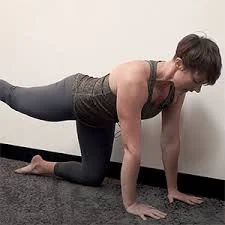
3-dimensional stability strength without the need for equipment
Steps To Follow:
- Lower yourself to your hands and knees.
- Make your abs tense.
- Stretch one arm forward as the other leg extends backward;
- hold the position for eight to ten seconds before switching to the other side
Prone Plank Variations
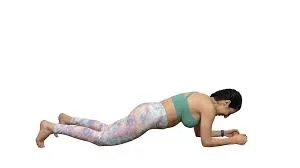
Strengthening stability in three dimensions without the need for equipment
Steps To Follow:
- To begin a prone plank.
- Start on your hands and knees (if you have wrist problems, do a forearm plank instead).
- Make your abs tense.
- Hold for 15 to 30 seconds.
- Then release and repeat.
Note: Do the same for the same length of time on your feet for an even larger challenge.
Squat
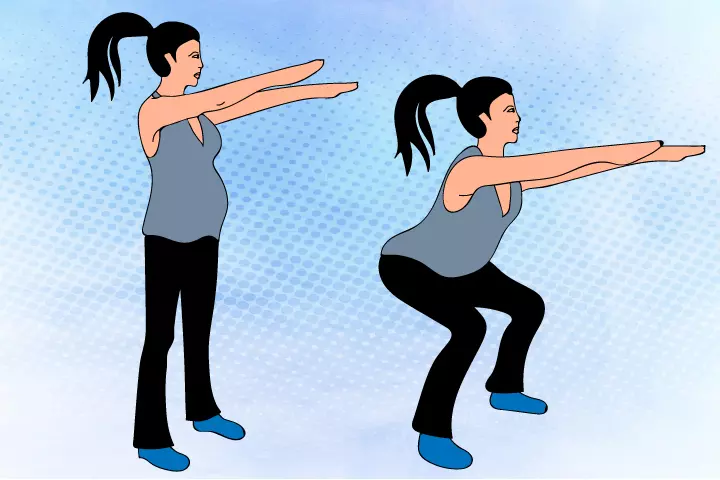
Some people might not be aware that, when performed properly, this is a good ab workout that can help you get ready for the pushing stage of delivery.
Steps To Follow:
- Stand erect, keeping your feet and hips apart.
- Raise your arms in front of your chest straight.
- Breathe in as you squat down, keeping your knees from giving way and your weight in your heels.
- When you reach the bottom, wait, and then release your breath as you stand up.
- Consider performing two to three sets of fifteen repetitions each.
Cat cow pose
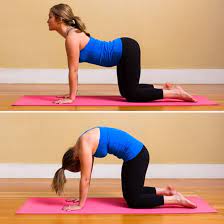
This improves the flexibility of your spine and back while also strengthening your core muscles.
Steps To Follow:
- Assume a tabletop position on the floor, placing your hands directly beneath your shoulders and your knees beneath your hips.
- Breathe in, raise your head, arch your back, and let your tummy dangle.
- After that, release the breath, tuck your chin and tailbone in, and pull your abdomen in towards your spine.
- Try to match as much of your breathing rhythm to your motions as you can as you continue this breathing and exhalation exercise.
- After about two minutes of repetition, stop, and start over.
Side-lying leg lifts

Your hip, glute, and core muscles are strengthened as a result.
Steps To Follow:
- Place your legs piled on top of each other as you lie on your left side.
- To allow your left elbow to support your upper body, keep it planted in the ground.
- Now, carefully raise just your right leg or both of your legs (advanced and more merely first trimester).
- Raise it as far as you are able to. Verify that your hips and body are in a straight line.
- Lower it to a height of approximately two inches over your left leg.
- Work on each leg for around 20 reps, or until your legs begin to tire.
Bird Dog Crunches
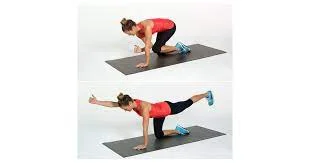
This is an abdominal strengthening exercise that improves stability.
Steps To Follow:
- Place your wrists directly under your shoulders, your legs under your hips, and your back straight to begin in a tabletop position.
- Keeping your core tight, slowly inhale, raise your left leg and extend it straight behind you, and raise your right arm straight ahead of you.
- Exhale and bring the left knee to the center of the right elbow.
- Inhale, exhale, and repeat ten to twelve times.
- Next, use the opposing hand and leg to perform the same actions again.
Standing pelvic tilt

It’s a great way to strengthen your back and abdominal muscles and help with posture.
Steps To Follow:
- Position yourself squarely against a wall, pressing your hips and back against it.
- There’s going to be a tiny gap between the wall and your lower back.
- Next, tilt your pelvis and contract your abs.
- your lower body Your lower back should start to flatten against the wall.
- Ten attempts should be made to complete this stance.
- Hold it for five seconds, then release it.
Hip hiker

It assists in strengthening the hip and glute muscles.
Steps To Follow:
- Take a comfortable position on your side.
- Keep your upper leg straight and bend your lower leg. To alleviate any discomfort, place a pillow under your head.
- Now lift your upper leg to a height of two to four inches above the ground.
- Maintain a straight leg. Pull your hip with the muscles on the side of your abdomen.
- Maintain the stance for around five seconds.
- Ten times over, repeat the steps.
Single Heel Drop

The glute muscles are strengthened by this workout.
Steps To Follow:
- Sleeping on your back, position your arms by your sides.
- Make a 90-degree bend in your knees.
- Maintaining the other leg at a ninety-degree angle, straighten one.
- Lower your straightened leg and clench your abs.
- Once it touches the ground, fold it back.
- With the other leg, repeat the step.
Heel slides

Steps To Follow:
- Begin in the glute bridge position on the ground.
- One leg at a time, raise your heel slightly over the floor.
- Return to your starting position gradually. (Tap with cloth or glider beneath heel)
- On the other leg, repeat.
Leg Raises
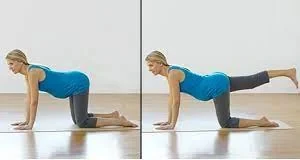
Leg lifts are a great way to strengthen your abdominal and back muscles.
Steps To Follow:
- With hands beneath shoulders, begin on all fours.
- Keep your arms extended to their greatest length.
- Raise your right knee off the ground and extend it back straight.
- With your right leg elevated, try to keep it parallel to the floor.
- Return your right knee to the floor with gentle pressure.
- Raise your left knee such that it is parallel to the floor and extends straight back.
- Return your left knee to its starting position with caution.
- Repeat the pattern on both sides to gradually increase in intensity.
- Try to finish as many as ten repetitions on each side.
No Crunch Crunches
it’s a great workout for building stronger abdominal muscles.
Steps To Follow:
- Lay comfortably on your back.
- Keep your feet on the ground
- bend your knees.
- Place your hands to the side and below the belly button.
- Apply a little pressure on the lower abdomen with two fingers on each hand.
- Now apply gentle pressure to the lower abdomen.
- Avoid moving your pelvis while performing this.
- Breathe normally as you lift your chest higher.
- You need to quit exercising right away as soon as you feel your abdominal muscles tightening.
- You may notice that the muscles beneath your fingertips are tense.
- After about ten seconds, hold the pose and release it.
- Perform twenty repetitions.
Engaging your TA
Steps To Follow:
- With one hand on your belly button, take a deep inhale while sitting or standing upright.
- Without elevating your shoulders, take a deep breath and hold it until you feel your lower rib cage and belly button expanding.
- Then release the air while tightening your TA and bringing your belly inward.
- Breathe controllably through 5–10 repetitions.
Before starting any fitness schedule, you should speak with your doctor. They can recommend workouts based on your general health.
Scissor Kicks
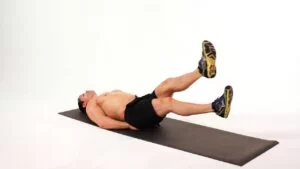
Work out your abs only during the first period. It is best to avoid it, even if you feel safe doing it in the next trimester.
Steps To Follow:
- With your hands flat beneath your hips, lie on your back.
- As much as you can, keep your back flat on the ground.
- One leg should be raised slowly, about ten inches off the ground.
- Lift one leg and begin lowering the lifted one.
- Perform ten scissor kicks in three sets. Take a brief break between each repetition.
Benefits Of Exercising During Pregnancy
With the changes you are expecting, you might need to consider your goals and viewpoint if your only motivation for working out is to fit into a smaller pair of jeans.
The American College of Obstetricians and Gynaecologists states that physical activity during pregnancy may reduce the risk of:
- Premature delivery,
- Cesarean delivery,
- Major weight gain
- Reduced birth weight due to gestational diabetes
- Hypertension conditions like preeclampsia
It’s also a great method for:
- keep up your physical health
- Decrease low back ache (hey, expanding belly!)
- Control your anxiety and depression
- Reduce tension
- Improve the healing process after childbirth
Certain activities can be done at the beginning of each month to help the body adjust to its physical changes and get ready for a simpler postpartum return to activity.
Before the actual changes happen, you can establish a stronger connection with your core by focusing on awareness of your pelvic floor and core.
12 Week Complete Pregnancy Workout Guide
The Complete Pregnancy Workout Guide offers a 12-week program of moderate-to-low-impact exercises that can be followed and repeated throughout every phase of pregnancy, as well as nutrition advice, exercises to help maintain a strong core and pelvic floor, tips for preparing for labor and delivery, and more!
You will first focus on building a strong foundation in order to tone your muscles, improve circulation, and build endurance. You will aim to minimize pregnancy aches and pains and strengthen and stabilize yourself as the weeks go by. Maintaining an active lifestyle can help you become stronger and more resilient, as well as reduce stress and get ready to give birth.
Every week there is yoga, active recovery, and resistance and strength training. Prenatal yoga and core exercises are part of active rehabilitation, preparing your body for delivery and the arrival of your precious child or kids!
- When to Begin Exercises During Pregnancy
- When you first find out you are pregnant is the ideal moment to begin prenatal exercises.
- Right now is the second best time to begin exercising during pregnancy. Of course, before starting any pregnancy exercises, receive the all-clear from your doctor, OB-GYN, or midwife.
- You may work out from home or anywhere else with these safe pregnancy exercises in this 12-week program!
- Requirements for equipment: loop band and dumbbells
Conclusion
Maintaining an active lifestyle throughout pregnancy is good for the mother and the unborn child. Engaging in physical activity on most days of the week can help maintain a strong core, well-defined muscles, and a healthy cardiovascular system. Moreover, it has positive effects on your mental health.
Pay attention to your body’s signals and quit if you experience any pain or discomfort. As usual, if you have any queries or worries regarding how your body is reacting to an exercise regimen, consult your doctor.
FAQs
Which physical activities are best to avoid when pregnant?
Activities to stay away from when expecting
hard objects or hitting tools, like in softball, cricket, or hockey. falling, including skating, horseback riding, and downhill skiing. extraordinary agility, coordination, and balance—like gymnastics. major pressure shifts, such as that experienced while SCUBA diving.
What types of exercise are safe to do whilst expecting?
Pregnancy is generally safe when engaging in these activities:
Walking.
Exercises in the water and swimming.
cycling in a stationary position.
Pilates and yoga courses.
classes of low-impact aerobics You always place one foot on the ground or the apparatus when doing low-impact aerobics.
Strengthening exercises.
I’m pregnant; can I still do planks?
Absolutely, most pregnant ladies can safely use planks. Planks and other static, endurance-based exercises are really great for expecting women since they strengthen the back and the abs. Furthermore, compared to dynamic exercises like crunches, they do not have as much strain on the spine.
I’m pregnant; can I run?
Indeed. It’s widely thought that running during pregnancy is safe for both you and the unborn child. Some women, however, should not exercise at all because of health issues or difficulties from pregnancy.
How far should a pregnant woman walk in a day?
Based on our experience, it is advised that pregnant women walk between 3000 and 4000 steps a day, or about a mile and a half, and that they do this every other day for the duration of their pregnancy, or as often as their bodies permit.
References
- Lagudu, S. (2024, January 10). 22 Safe & Effective Abdominal (Ab) Exercises During Pregnancy. MomJunction. https://www.momjunction.com/articles/abdominal-exercises-during-pregnancy_00366835/
- Lindberg, S. (2020, April 30). The Best Pregnancy-Safe Exercises at Home and the Gym. Healthline. https://www.healthline.com/health/pregnancy/pregnancy-workouts#benefits

